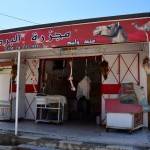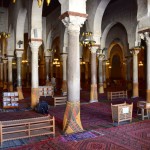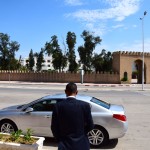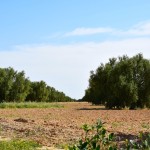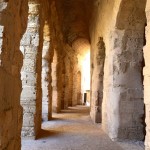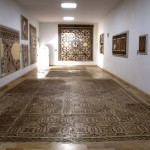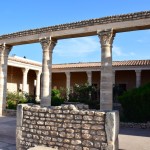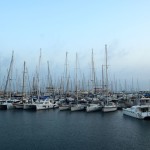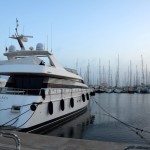Atlas North: A Tour through Portugal, Morocco, Tunisia, and Algeria
A day tour visiting the ancient cities of Kairouan and El Djem. Stopping by the Yasmine Hammamet marina and new medina.
The world’s third most important Islamic center and the most well preserved Roman amphitheater can be visited in a single day. I opted to take another tour organized by the hotel, Hasdrubal Thalassa in Hammamet to see these sights.
After a leisurely breakfast and a tour of the hotel, I left around noon to start the journey. I had a different driver and a slicker car, a Peugeot 308, for the day.
The drive to Kairouan was about an hour or so of which we conversed in basic French on the cities and current situation of Tunisia. On the way we saw huge stork nests at the top of many electricity poles, shops selling gas by the bottle, camel meat, and pottery.
Kairouan
This Islamic capital is the world’s third most important Islamic city after Mecca and Medina. Founded ~ 670, it is now listed as a UNESCO World Heritage site. Interestingly scenes from Raiders of the Lost Ark were filmed on the streets of the city.
My guide explained the city is also famous for its tapestries and pastries. The city can be visited with a single ticket that includes many sights.
Great Mosque of Kairouan
The Great Mosque of Sidi-Uqba built ~ 670 is known as the ancestor of all mosques and is the most important site in the city. The 414 columns used in the construction were all taken from Carthage and most of the construction is original.
On entrance I had to buy a ticket and then put on a robe because I was wearing shorts.
Admiring the ornate carvings, I was not allowed into the prayer area.
Mosque of the Barber
Also known as the Mausoleum of Sidi Sahab, this mosque was once a zawiya, an Islamic school. The name comes from a companion that kept three hairs of prophet Muhammad’s beard.
There was a bus load of tourist during my visit but I still was able to witness the intricate designs on the walls and ceilings. My guide even helped me snap some pictures from inside the mausoleum which is forbidden to non-muslims.
Aghlabid Basins
These holding basins collected water via aqueducts from the mountains 36 kms away.
You can enjoy the magnitude of the basins from a viewing platform.
Medina
The walled medina had a wide street of stores with alleys leading to more shops. It was much calmer than the chaotic medinas of Marrakech or Fez in Morocco.
We perused the local specialties in the candy and rug shops.
Bir Barrouta
My guide led me to one of the oldest wells in the city built in 796. Walking up the stairs we found a camel strapped to a waterwheel. The camel circles the well in a single direction to collect water.
The building seemed sacred as locals came to pray and offer donations.
With another city to village and time not on our side, we were off.
The drive was another hour and on the way we saw makeshift gas stations, BBQ restaurants with live sheep tied to a pole ready for the grill and many olive tree farms.
El Djem
This Roman city flourished for its olive oil market and could have been the second most important Roman city in Africa after Carthage. It was destroyed by Roman soldiers when an uprising started.
El Djem also was the site of a major airfield, which was used by the German Luftwaffe and later by the US Air Force. The city was a filming location for both Monty Python’s Life of Brian and Gladiator.
Amphitheater of El Djem
The city’s hallmark is was registered as a UNESCO World Heritage Site in 1979. Said to be the third largest and best preserved, the towering amphitheater could be spotting right from the edge of town. Stones from the structure were also used to build the Great Mosque of Kairouan.
With few tourists especially during the prayer time, I felt like I had the whole site to myself. Three floors and the underground level, where animals and gladiators were kept, were accessible to visit.
Seated in the stands, I envisioned a packed amphitheater cheering for the bloody combat below. It was an awe-inspiring experience.
El Djem Museum
The museum was located a short distance away. It is built on the ruins of a Roman villa. The halls hung complete mosaics and sculptures found in the area.
In the back of the museum is the remains of Roman courtyards still retaining their original mosaic floorings. Incredible.
There was even a pigeon coop for Romans to send messages by carrier pigeon!
Back in Yasmine Hammamet we stopped by the marina to see the yachts and boats. The walkway was full of people shopping and taking pictures. The New Medina was also packed with tourists enjoying the cool evening.
I had dinner at the hotel and tried Ojja, a Tunisian dish made of mixed eggs and meat, with a local beer. I followed the meal with a relaxing chicha in the Moorish Cafe while the musician skillfully played his oud, a guitar-like instrument.
Images of Tunisia’s diverse landscapes and landmarks ran through my head. There was so much more to see and I looked forward to my next trip to this mystifying country.
With a flight to Algeria the next day, I took advantage of the luxury of sleep.



